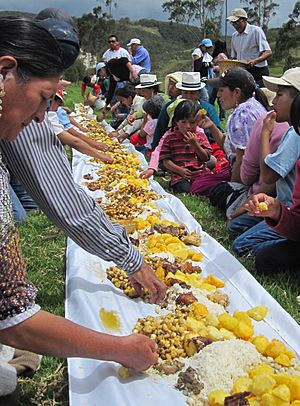Pampa mesa facts for kids
Imagine a giant picnic where everyone shares! A pampa mesa (also called pamba mesa) is a special meal shared by communities in the mountains of Ecuador. People lay food directly on a big cloth spread on the ground. It's a way for everyone to eat together and show they care about each other. It also has special meanings related to old stories and beliefs.
Contents
What Does "Pampa Mesa" Mean?
The name "pampa mesa" tells you exactly what it is! It comes from two languages.
- The first part, pampa, is a word from the Kichwa language. It means "ground" or "plain."
- The second part, mesa, is a Spanish word. It means "table."
So, "pampa mesa" basically means "ground table" or "table on the ground."
When Do People Have a Pampa Mesa?
No one knows exactly when the pampa mesa tradition started. But it's a very old and important custom. People often have pampa mesas during:
- Big festivals and celebrations.
- Family gatherings, like birthdays or weddings.
- After a minga. A minga is when a whole community works together on a project. It could be building a road or planting crops. The pampa mesa is a way to thank everyone for their hard work.
How Does a Pampa Mesa Work?
Having a pampa mesa is a special event. Here's how it usually happens:
Setting Up the "Table"
First, a long cloth is spread out on the ground. This cloth is usually white. It acts like a giant tablecloth for everyone.
Sharing the Food
Everyone who comes to the pampa mesa brings some food to share. They spread their food right onto the cloth for everyone to enjoy. This way, there's a huge variety of dishes for everyone to try. It shows how people support each other.
Eating Together
Once all the food is laid out, people sit around the cloth. They eat with their hands instead of using forks or spoons. This makes the meal feel even more connected to the earth and to each other.
Giving Thanks
Before eating, a community leader might say thanks for the food. Sometimes, a small part of the food is buried. This is an offering to the earth, showing respect for where the food comes from.
What Kind of Food Is Served?
The food at a pampa mesa is usually made of common, healthy ingredients. These are foods that grow well in the mountains.
- Main foods: You'll often see mote (a type of corn), potatoes, quinoa, oca, carrots, and fava beans.
- Meats: Sometimes, special meats like cuy (guinea pig) are served.
- Decorations: People might use colorful flowers and fresh fruits to make the pampa mesa look even more beautiful.
- Condiments: A spicy sauce called ají is almost always there.
- Drinks: A traditional fermented drink called chicha de jora might also be served.
Similar Traditions
Other countries in South America have similar ways of sharing food. For example, in Peru and Bolivia, there's a tradition called apthapi. It's also a communal meal where everyone brings food to share on a cloth.


